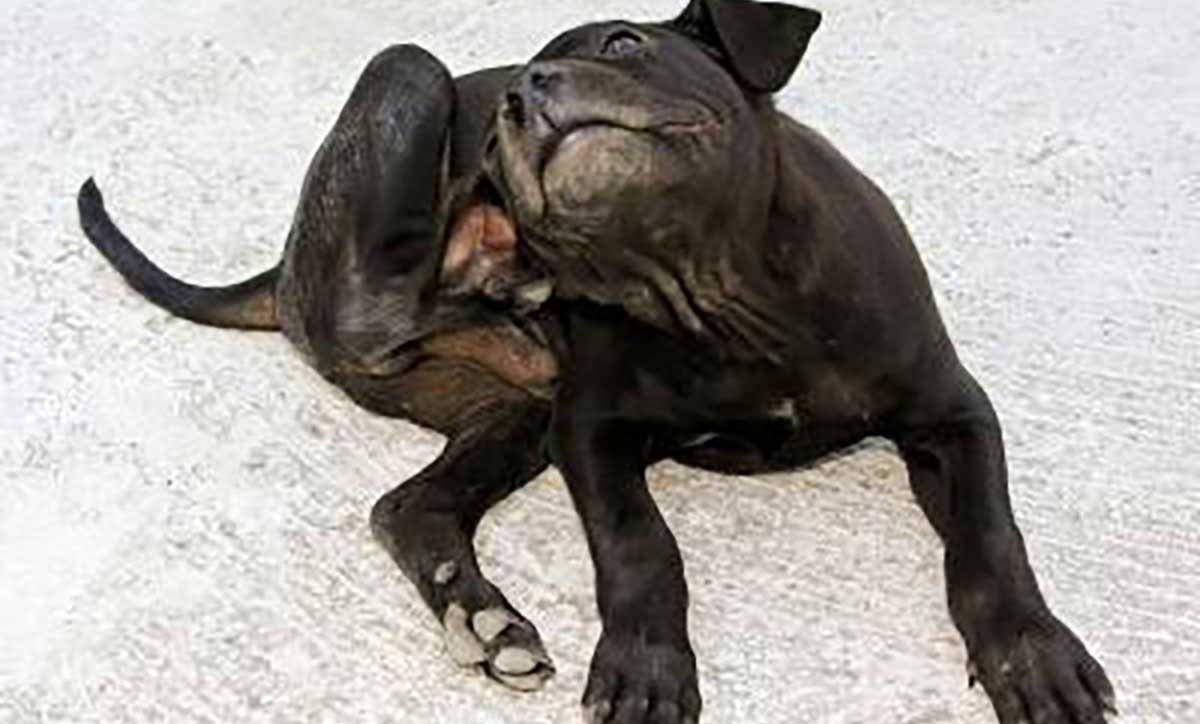What are allergies?
Just like people, dogs can show allergic symptoms when their immune systems begin to recognize certain everyday substances (allergens) as dangerous. This sets off an inflammatory response which causes harm instead of helping. In dogs, this reaction usually affects the skin and causes inflammation and itchiness which can result in them chewing or scratching themselves raw.
What are the general symptoms of allergies in dogs?
- Itchiness
- Red skin
- Hair loss
- Foot chewing/licking
- Ear infections
- Skin infections
- Thickened dark skin
Which dogs are at risk of getting allergies?
Any dog can develop allergies, but allergic reactions seem to be especially common in Staffordshire bull terriers, Jack Russell terriers, golden retrievers, labrador retrievers, bull terriers, west highland white terriers, cavalier king Charles spaniels and short-nosed breeds such as pugs, bulldogs and Boston terriers. Most allergies develop during the first 5 years of life.
What substances can dogs be allergic to?
Dogs can develop allergies to a vast range of substances and most allergic dogs react to multiple allergens. A few common allergens include:
- Fleas
- Tree, grass and weed pollens
- Mould spores
- Dust mites
- Food ingredients (e.g. beef, chicken, pork, corn, wheat or soy)
- Certain plants such as wandering jew
- Rubber and plastic materials
What are the different types of allergies?
Atopy (also known as eczema in humans) accounts for around 80% of allergies in dogs. It is usually triggered by airborn allergens which are inhaled and cause an allergic reaction throughout the body. Atopy also includes flea allergy which is very common.
Food allergies are triggered by a protein in the food, such as beef, chicken, pork, or wheat protein. Food allergies develop in young dogs and are usually caused by a regular component of the diet rather than something new.
Contact allergies are much less common than atopy and are caused by direct contact with the allergy causing substance. Grasses, certain plants and plastics can cause contact allergy in occasional dogs.
What should I do if I think my dog has allergies?
Visit your veterinarian. After taking a thorough history and conducting a full physical examination, he or she will usually be able to confirm whether your dog has allergies or whether there is some other type of skin disease. They will also evaluate your dog for secondary ear or skin infections. This involves tests such as ear swabs, skin scrapes or tape cytology for evaluation under the microscope. Whilst a diagnosis of allergic dermatitis can often be made during the initial consultation, further testing is usually required to determine the type of allergy and the specific cause.
How are dog allergies diagnosed?
If your dog’s itchy, red or irritated skin persists beyond initial treatment by a veterinarian, then further testing is warranted to determine the underlying cause.
The first step is to rule out food allergies. The only way to diagnose a food allergy is to perform an elimination diet trial where you feed your dog a special hydrolyzed protein diet (Hills z/d) exclusively for 12 weeks. The importance of not feeding your dog anything but the diet cannot be emphasized enough—that means no treats, bones, table scraps or flavoured medication. If your dog’s allergies improve on the elimination diet and relapse once the old diet is reintroduced then your dog has a food allergy. At this point, you can either continue to feed z/d long term or reintroduce old foods one at a time to see which ones might be causing the allergic reaction.
Once food allergy has been ruled out it is time to consider allergy testing. This can be performed with either a blood test or skin prick test to confirm the diagnosis of atopy and identify the specific pollens, moulds or other substances which are causing the allergy. Once the specific causes are known then desensitization therapy can be commenced.
How can dog allergies be treated?
The first thing to realize is that allergies are not cured, they are managed. This means that treatment will be required for your pets entire life.
- Prevention is the best treatment for allergies caused by fleas. Not all flea products are the same so it is essential that you seek advice from your vet about the most appropriate flea prevention to suit your pet’s lifestyles. If you treat every cat and dog in the household regularly with a suitable product then you can keep your household flea free. This means no more flea allergies.
- As we have previously discussed, food allergies can be controlled by managing your pet’s diet. Remember that even a tiny amount of the offending protein can set off food allergy symptoms so don’t be tempted to give an occasional treat or morsel of your food containing a protein your dog is allergic to.
- Contact allergies can be controlled by eliminating the plant or substance which triggers your pet’s allergy.
- Atopy is the most difficult form of allergy to treat since it is rarely possible to prevent exposure to airborne allergens like pollens, dust mites or mould spores. A multi-pronged approach is usually needed. This consists of medication to control any severe flare-ups along with ongoing treatment to reduce the allergies and prevent flare-ups from occurring. Treatment of flare-ups involves treating any secondary infections and using anti-inflammatory medications (cortisone based injections, tablets or sprays) to regain control of the allergies and prevent the severe itchiness your pet is experiencing. Whilst cortisone is the only medication which acts rapidly enough to control flare-ups, there are safer alternatives to use for long term allergy control. The best long term treatment is desensitization injections which help your pet develop resistance to the offending agent, instead of just masking the itch. Another alternative is a medication called atopica which acts to dampen down your pets overactive immune system. For dogs which have small areas of skin affected, a spray called cortavance can provide good control without the need for injections or tablets. The most appropriate option for you and your pet will depend on factors such as the age of your pet, how often your pet’s allergies flare up, how much of your pet’s skin is affected and your budget. Your veterinarian will be able to guide you through the options and find one which suits your needs.
- Weekly bathing may help relieve itching and remove environmental allergens and pollens from your dog’s skin. Discuss with your vet what prescription shampoos are best, as frequent bathing with the wrong product can dry out the skin.
- Fatty acid supplements also act to reduce skin inflammation. These can be provided in the form of special diets or supplements which can be added to your pets regular diet.
- Antihistamines can be used, but only benefit a small percentage of dogs with allergies. Ask your vet first.




